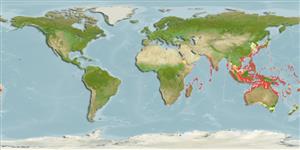Environment: milieu / climate zone / depth range / distribution range
पारिस्थितिकी
समुद्री प्रवाल-भित्ति संयुक्त; गहराई सीमा 1 - 55 m (Ref. 9710). Subtropical
Indo-West Pacific: tropical and subtropical waters, South Africa eastward through Indonesia; northward to southern Japan; southward to the east coast of Australia (Ref. 33352). Southeast Atlantic: south coast of South Africa.
आकार / वज़न / Age
Maturity: Lm ? range ? - ? cm
Max length : 19.0 cm TL पुल्लिंग / अलिंग; (Ref. 9710)
पृष्ठीय रीढ़ (सम्पूर्ण) : 2; पृष्ठीय सौफट रेज़ (सम्पूर्ण) : 43 - 50; गुदा कांटा: 0; ऐनल सौफट रेज़: 41 - 46. Pale brown to grey in color; two brown stripes on body; adults with yellow spots on head and body; soft dorsal and anal fins yellowish; caudal fin dark brown (Ref. 4421).
Inhabit coastal reefs and enter estuaries. Often in silty habitat and usually on slopes with low rubble reef and rich invertebrate growth, ranging to moderate depths (Ref. 48637). Found on weedy and sandy areas of lagoon and seaward reefs (Ref. 9710). Often found in pairs (Ref. 9710). Sometimes solitary or in groups (Ref. 90102). Juveniles hide or shelter near seawhips or seapens (Ref. 48637).
Life cycle and mating behavior
परिपक्व अवधि | पुनरुत्पत्ति | मछलीऔ का अंडे देना | अंडे | Fecundity | लार्वा
Masuda, H., K. Amaoka, C. Araga, T. Uyeno and T. Yoshino, 1984. The fishes of the Japanese Archipelago. Vol. 1. Tokai University Press, Tokyo, Japan. 437 p. (text). (Ref. 559)
IUCN Red List Status (Ref. 130435: Version 2024-1)
Threat to humans
Harmless
Human uses
साधन
Special reports
Download XML
इंटरनेट स्रोत
Estimates based on models
Preferred temperature (Ref.
123201): 22.4 - 29, mean 27.7 °C (based on 974 cells).
Phylogenetic diversity index (Ref.
82804): PD
50 = 1.0000 [Uniqueness, from 0.5 = low to 2.0 = high].
Bayesian length-weight: a=0.00955 (0.00501 - 0.01821), b=3.07 (2.90 - 3.24), in cm total length, based on LWR estimates for this species & (Sub)family-body (Ref.
93245).
Trophic level (Ref.
69278): 3.1 ±0.0 se; based on diet studies.
लौटाव (Ref.
120179): ऊंचा, न्यूनतम जनसंख्या दुगनी समय अवलागत 15 महीने। (Preliminary K or Fecundity.).
Fishing Vulnerability (Ref.
59153): Low vulnerability (10 of 100).
Nutrients (Ref.
124155): Calcium = 38.9 [14.5, 124.6] mg/100g; Iron = 0.757 [0.328, 1.742] mg/100g; Protein = 19.2 [17.0, 21.4] %; Omega3 = 0.227 [0.099, 0.466] g/100g; Selenium = 13.9 [6.2, 32.8] μg/100g; VitaminA = 62.3 [20.9, 191.6] μg/100g; Zinc = 1.04 [0.65, 1.73] mg/100g (wet weight);
